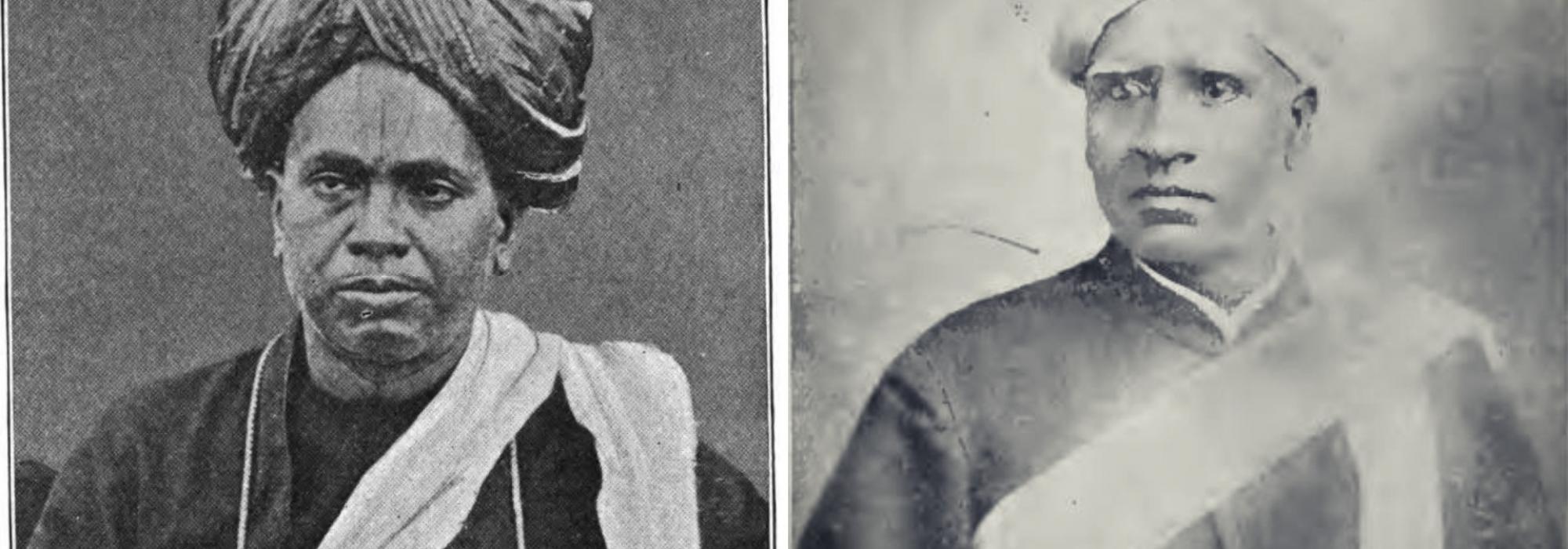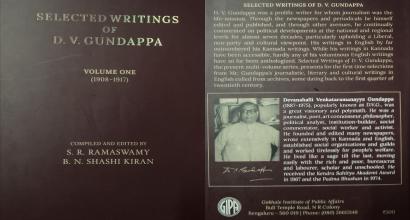I haven’t found the means to determine the period that marks the commencement of efforts towards giving an integrated structure to public life in the State of Mysore. Such efforts had already taken place in the State of Madras by 1852-53. Even before the Sepoy Mutiny (also known as The First War of Indian Independence) of 1857, an organization called the Madras Native Association had been formed. Gajalu Lakshminarasu Chetty, G Purushotthama Naidu, and a few other public luminaries were its leaders. This organization analyzed and documented the performance of the Government of Madras and along with views and expectations of its citizens, sent it to the British parliament as well as the Indian government, in the form of a detailed annual report. It also stood in support of a few newspapers of the day.
Our Diwan Rangacharlu[1] was one of the people who grew up in the atmosphere of this organization. I’ve heard that he was an enthusiastic contributor to some of the public institutions and newspapers of Madras.
When Rangacharlu took charge as Diwan of Mysore, it is no surprise if he took the initiative to persuade local leaders of that time to establish a public institution within the ambit of the province. I’ve heard from Venkatakrishnaiah[2] of Mysore that indeed Rangacharlu advised people along those lines. But it doesn’t seem like his recommendations came into effect. Rangacharlu was the Diwan of Mysore for a period not exceeding two years (c. 1881–83). There might not have been enough time for his advice to bear fruit.
However, it seems that Rangacharlu helped establish a few organizations in the areas of education and culture. The ‘Literary Unions’ of Bangalore and Mysore were prominent bodies among them. Bangalore’s literary union is functional to this day as a part of the Bar Council, in the District Office premises. Under the aegis of this organization, in 1880, Pandit Shibnath Shastri[3] of Bengal delivered a lecture on Social Refinement. Rangacharlu attended the event and had addressed the gathering. He used to actively participate in events of this organization on numerous such occasions. At about this same time, Rangacharlu was intent upon appointing a personal tutor (‘tutor companion’) to Chamarajendra Wadiyar X.[4] He wanted a Mysorean, well-versed in Kannada to take up this responsible position. At around the same time, Krishna Rao of Naladurga had earned his MA degree from Madras University. Rangacharlu had heard about him through someone and harboured a desire to know about his personality and the power of his oration by meeting him in person; therefore he suggested to the Bangalore literary union that they organize a lecture by Krishna Rao. As suggested, the lecture was arranged. Rangacharlu was present during the lecture. He appreciated Krishna Rao’s scholarship and appointed him as an attaché (officer in the staff of an important personage). Bangalore’s literary union of those days thus turned out to be beneficial in more ways than one.
During the tenure of Sir K Sheshadri Iyer[5], it doesn’t seem like much support was extended to public participation in governance. That was a period of bureaucratic arrogance. In addition to Sheshadri Iyer’s high degree of competence, he was surrounded by a team of capable executives who reinforced his vision – this was the situation. Wherever they went, this group of executives would shower praise on Iyer’s charisma and his influence and therefore the general public were mesmerised by the grandeur of his name. Why should the citizens be concerned when there is an omnipotent diwan competent enough to look after everything? This appears to be the predominant mindset back then. The voice of the general public doesn’t seem to have been heard during Sheshadri Iyer’s tenure with the exception of the questions raised by a few newspapers like the Deśābhimāni and the criticism of a few members of the Citizens Representative Assembly (ಪ್ರಜಾಪ್ರತಿನಿಧಿ ಸಭೆ).
Around 1892, there was a notable incident that transpired. In those days, the Citizens Representative Assembly typically met once a year. There wasn’t a system in place to scrutinize and redress the government’s daily administrative actions throughout the year. A few members requested Diwan Sheshadri Iyer for the formation of a central committee that functioned through the year—between the annual meetings—offering recommendations and giving advice to the government on behalf of the Citizens Representative Assembly.
This request came from a few Indians like M Venkatakrishnaiah, D Venkataramayya, and C Srinivasa Rao as well as from a few foreigners like Reverend Haigh and Coffee planter Anderson. Sheshadri Iyer did not agree to this. The members of the Citizens Representative Assembly met privately, appointed a Standing Committee, requested the government to recognise its presence as a working subsidiary of the Citizens Representative Assembly, and appealed to the government to send them a copy of government reports, legislative plans, and other important documents for their review and suggestions. Sheshadri Iyer’s government never responded to this request. A few members raised this issue in the following year’s assembly meeting.
Member: “Where’s the government’s response to our proposal of a Standing Committee?”
Sheshadri Iyer: “Your committee burnt down.”
Member: “The committee has a few members who can’t be burnt.”
Sheshadri Iyer: “If so, then it has been buried!”
There weren’t many people possessing sufficient courage and selflessness to retort when the chief of the government made such statements. A few members even joined the laughter of the government officials; many remained indifferent. The Assembly’s intention to set up a Standing Committee remained just a thought.
To my knowledge, the first attempt made to independently congregate the members of the Citizens Representative Assembly took place in 1909. By then I had written Diwan Rangacharlu’s biography. The influence of his conception of democracy had freshly engulfed my mind. In my enthusiasm, I travelled to Mysore and met with Venkatakrishnaiah and other luminaries, sharing my thoughts with them. Members of the Citizens Representative Assembly are a bridge between the government and the general public. One on side, they must stay updated with the people’s minds and on the other, they must constantly rectify the government’s mind. For this endeavour to be fruitful, it wouldn’t suffice if they travelled to Mysore, attending a few meetings, for merely four or five days out of the three-hundred-and-sixty-five. Month upon month they must engage in their work, without a break. They must establish an institution that is instrumental to the work. The working committees of this institution must continually foster the general public on one end and the government on the other. This was my proposition. I remember well my frequent requests to Haasan’s H V Rangaswamy, one of the younger members of the Citizens Representative Assembly.
Venkatakrishnaiah was in agreement with my idea. He gained the support of other members. Subsequently, one evening, a meeting was held in Mysore’s Nanjaraja Bahadur Choultry and the Mysore Public Council (ಮೈಸೂರು ಸಾರ್ವಜನಿಕ ಸಭೆ) was established. Advocate Santebachahalli Nanjappa was nominated as its secretary.
Santebachahalli Nanjappa was a famous personage; a man of sattva. Among the traits that made him popular with all, two are important: a. his sense of humour and b. his elegant handwriting. It is extremely rare to find a person who could write letters of the Kannada alphabet (and English as well) neater than him. Similarly, it was rare to find a person equal to him in narrating humorous anecdotes and making people laugh. I had written the draft of the rules of conduct for the working of the Council. The members of the Council had made edits to the document and then had it printed.
The activities of the Council, however, did not go on as intended. That institution existed merely in name for about two or three years and vanished from sight. What else would happen to an institution that was to carry out activities from its own funds without any financial support from the government? That is the state of a public undertaking without money.
Around this period, there were a few young people in Bangalore, filled with fresh enthusiasm in public affairs. They found asylum in K S Krishna Iyer’s house in Chickpet. Krishna Iyer was from a respected household. During those times, it was not impossible for a person like him, born in a famous family and having passed his BA (Bachelor of Arts), to get a job with the government if he so desired. Krishna Iyer did not let his mind wander in that direction and decided that he would earn his livelihood by pursuing an independent enterprise. Five or six of us gathered around him. His spacious house, large-heartedness, modesty, ethical nature, friendliness, magnanimity, graciousness, respect for knowledge and the learned – these qualities made the shelter he offered attractive.
Further, the fact that K T Appanna's Hindu Coffee Club was situated nearby was another attraction. Typically, seven or eight of us would be at Krishna Iyer’s house every morning and evening. Krishna Iyer had subscribed to many newspapers. Among those, Aurobindo Ghose’s daily Vande Mataram and weekly Karma Yogi ‒ these two English newspapers were extremely stimulating. That was the period of the Bengal revolution; the era of Tilak. Amidst our coffee and snacks, every now and then, discussions about public affairs would go on. Among the ceremonies born out of those, one part was the commemoration of the death anniversaries of freedom fighters and patriots. I have alluded to one such celebration of the death anniversary of Ranade in the chapter on D Venkataramayya.
This is the first part of a four-part English translation of the seventeenth chapter of D V Gundappa’s Jnapakachitrashaale (Volume 1) – Sahiti Sajjana Sarvajanikaru. DVG wrote this series in the early 1950s. Thanks to Śatāvadhāni Dr. R Ganesh for his review. Edited by Hari Ravikumar.
Footnotes
[1] Chettipunyam Veeravalli Rangacharlu (1831–83) was a civil servant and administrator who served as the Diwan of Mysore from 1881 to 83.
[2] M Venkatakrishnaiah (1844–1933) was a pioneering journalist, author, social reformer, educator, civil servant and philanthropist.
[3] Shivnath Shastri (1847–1919) was a scholar, religious reformer, educator, author, and historian.
[4] Maharaja Chamarajendra Wadiyar X (1863–94) was the twenty-third maharaja of the Kingdom of Mysore, between 1868 and 1894.
[5] Sir Kumarapuram Seshadri Iyer (1845–1901) was an advocate who served as the Diwan of Mysore from 1883 to 1901. He was the longest serving Diwan of the princely state.









































